Top Medicine Delivery Apps in India
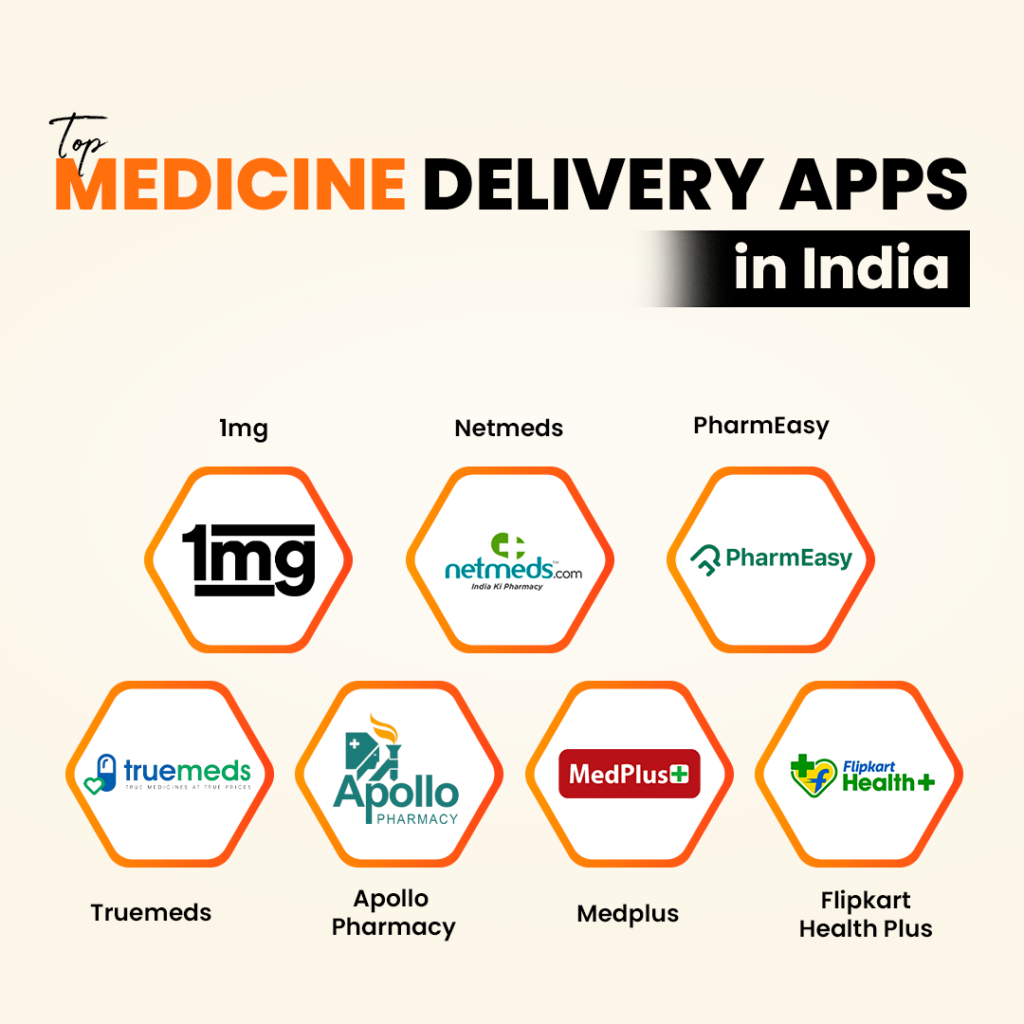
Market Overview Of Online Pharmacy
As we look at healthcare and technology in 2025, we see that the need for apps that send medicines has grown at a rate that has never been seen before. Many things are causing this rise, such as smartphones becoming more popular worldwide, people needing easy access to healthcare services, and the ongoing digital change in the healthcare sector.
By 2026, the global e-pharmacy market, which includes apps that send medicines, should be worth about $177 billion. It will be growing at a rate of about 17.3% per year from 2019 to 2026. This rise shows a strong need for online services that send medicines.
A poll in late 2023 found that 60% of people prefer digital platforms for regular healthcare needs, such as buying medications because they are more convenient and quick. Patients are 50% more engaged and satisfied with their healthcare when they use digital solutions. These solutions offer personalized care, medicine alerts, and easy access to medical information.
In this blog, we’ll talk about everything there is to know about medicine delivery apps, including their benefits, importance, and the technology needed to make them.
What is Medicine Delivery App Development?
Medicine delivery app development is making software programs that make it easier for people to order and get prescription and over-the-counter drugs sent to their homes. By making buying medicine easier to get to, easier, and faster, these apps act as a digital link between pharmacists, healthcare workers, and customers. Several important parts of the development process are designing the user interface, building the web server, integrating the drugstore database, processing payments safely, and ensuring the project meets all healthcare regulations.
Features of Medicine Delivery App
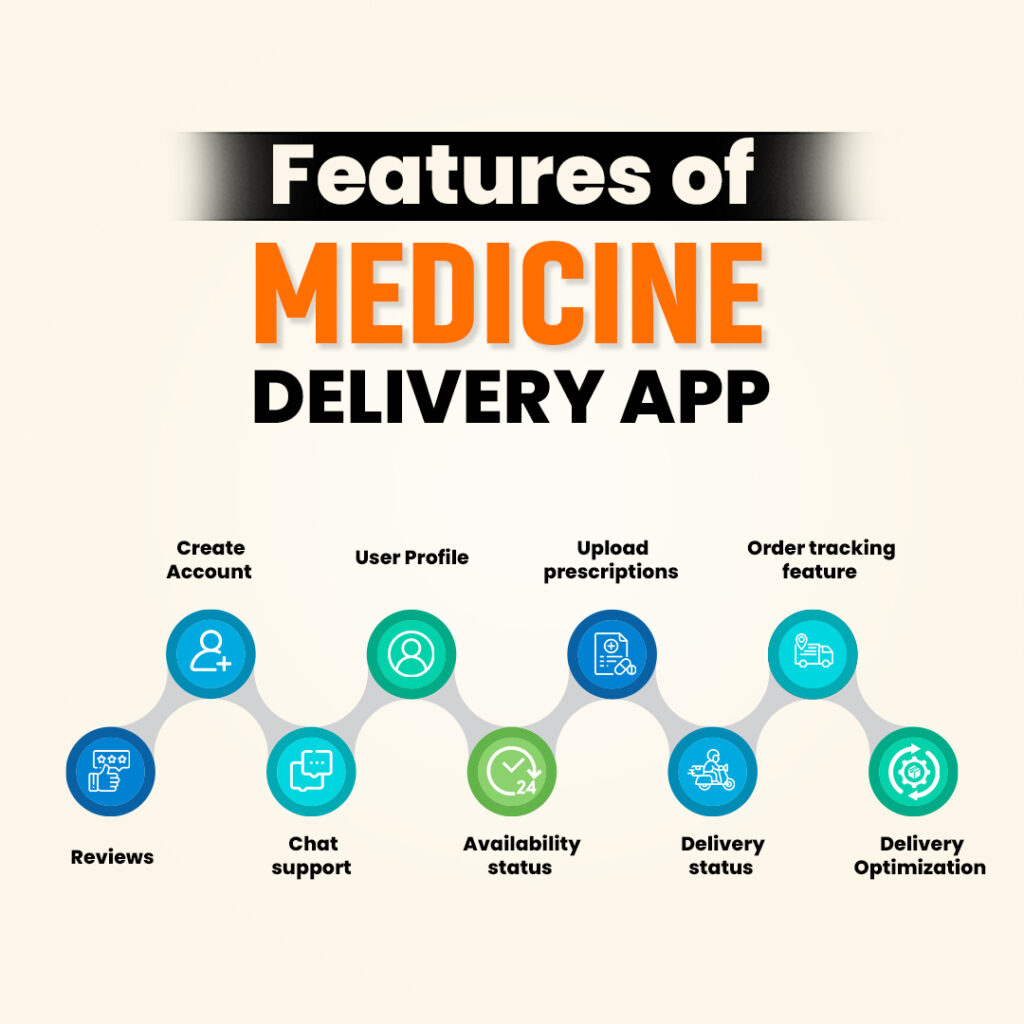
The main goals of a medicine delivery app are to improve the user experience, make buying easier, and make sure that drugs are delivered safely and quickly. Take a close look at each feature below:
1. Signing up as a user and making a profile
Users can sign up and make personal accounts where they can control their details, allergens, medical backgrounds, and preferences.
Benefits: It makes the user experience more unique and lets the app provide personalized services and suggestions.
2. Uploading and checking the prescription
The app lets users share their medications, which qualified doctors or other medical experts check before handling the order.
Benefits: It ensures that medicines are given out properly and in line with health and legal rules.
3. Finding medicines and putting them into groups
The goal is to make it easy for users to find the drugs they need by searching for them and browsing through groups like diabetes, cold and flu, and heart health.
Benefits: It makes the user experience better by making it easier to find and learn about medicines, such as how to use them, any side effects, and situations where they shouldn’t be used.
4. Getting together with pharmacies
Connects the app to drugstore management systems so supplies can be updated in real-time and orders can be processed and sent out.
Benefits: It makes buying easier, ensures the product is managed correctly, and reduces user wait times.
5. Order Tracking and Delivery information
This feature lets customers see the progress of their orders and when they will be delivered in real-time from the drugstore to their door.
Benefits: It builds trust and openness by keeping customers updated on the progress of their orders.
6. Integration of a Payment Gateway
This adds safe ways to pay to the app, like credit/debit cards, digital wallets, and cash on delivery.
Benefits: Offers a variety of easy and flexible payment options, improving the whole user experience.
7. Chatbots and customer service
Offers live chat, robots, or a service 24 hours a day, seven days a week for questions, order problems, or help.
Benefits: Customers are happier when they get help quickly, and problems are solved quickly.
8. Push notifications to remind you of things and send you deals
Sends prompt reminders for medicine refills, information on the progress of orders, and special deals.
Benefits: It keeps users interested by asking them to refill their medicines on time and telling them about sales or discounts, which could lead to more trust and return business.
If these key features are used well, they can help a medicine delivery app stand out in the crowded healthcare market by giving users an easy, safe, and smooth way to get their medicines.
Advantages of Adding the App for Delivering Medicines to the Drugstore Business
There are many benefits to adding a drug delivery app to a pharmacy’s business, such as making the customer experience better, improving processes, and making more money. Here are a few of the most important pros:
Wider Customer Reach
An app lets businesses reach customers who can’t visit in person for distance, health, or ease.
Effect: This could bring in many more customers and help the drugstore business reach new customers.
Better customer convenience
People can order their medicines whenever and wherever they want, without going somewhere or waiting in line.
Effect: This ease of use can make customers happier and more faithful, leading to more return business.
Better efficiency and productivity
By automating the order and transport process, the drugstore staff has less work and can focus on giving better care and advice.
Effect: The app can also help with upselling and cross-selling by sending messages and suggestions about sales or deals.
Better Inventory Management
Integrating with the pharmacy’s inventory system lets you see how much stock you have at all times, so you don’t have to worry about running out or having too much stock.
Effect: This could make managing supplies easier, reduce waste, and ensure that common medicines are always available.
Enhanced Data Insights
The app can gather useful information about what customers like, how often they buy, and what medications they take.
Effect: These insights can help businesses make choices, make the customer experience more personalized, and find ways to grow or improve.
Better Health Outcomes
Features like medication alerts, information on drug combinations, and an easy way to refill orders can help people take their medicines as prescribed.
Effect: As a result, patients may get better health, which can boost the pharmacy’s image and earn more trust from patients.
Following the rules and staying safe
The app can ensure that all transactions, including the handling of medications and private customer information, align with healthcare rules.
Effect: This keeps the pharmacy out of trouble with the law and builds trust among customers in the pharmacy’s safety and privacy commitments.
Adding a medicine delivery app to a pharmacy is a smart business move that can give you an edge in the digital world we live in now. It not only meets the needs of customers who want things to be easy to get to and convenient, but it also shows that the drugstore is forward-thinking and focused on its customers.
Technology & Platform Selection for Medicine Delivery App Development
Choosing the right technology stack is very important for the success of a medicine delivery app. The technology stack comprises the computer languages, libraries, databases, and development tools used to make an app. Here is a list of the most important things to think about when picking the right technology stack for a medicine delivery app:
1. Picking the right platform
- The two main systems for making mobile apps are iOS and Android. Which one to use (or whether to create for both) rests on the people you want to reach and where you want to spend your efforts. Swift or Objective-C make iOS apps, while Kotlin or Java are mostly used to make Android apps.
- Frameworks such as React Native, Flutter, and Xamarin make it possible to make apps that work on iOS and Android from the same source. This can be a cheap way to do things, especially for new businesses that need to reach many people quickly.
2. Things to Think About Backend Development
- Languages for programming: Node.js (JavaScript), Ruby on Rails (Ruby), Django (Python), and .NET (C#) are all popular picks. The choice is based on the needs of the app, the developer’s skills, and the need for growth.
- Frameworks: These make it possible to build the backend of an app, which includes things like managing users, storing data, and running business logic. There are tools for each computer language that can speed up development and ensure the program works well.
3. Taking care of databases
- Regarding organized data and complicated searches, MySQL, PostgreSQL, and Microsoft SQL Server are popular SQL databases. They are great for keeping track of user names, order records, and product information.
- NoSQL databases like MongoDB, Cassandra, and Firebase can handle unorganized data and are flexible and scalable. You can also store chat notes, logs, or real-time info on them.
4. Safety Steps to Keep Your Data Safe Encryption
To protect user data and follow the rules, you must use SSL/TLS for data transfer and encrypt private data while it’s at rest (for example, with AES).
- Verification and Authorization: OAuth, JWT (JSON Web Tokens), and multi-factor verification can protect user accounts and make sure that only people who are allowed to can see certain data or use certain features.
- Security Audits regularly: Security audits and vulnerability tests can help find and fix possible security risks.
5. Services in the cloud for expanding
- Cloud Providers: Amazon Web Services (AWS), Google Cloud Platform, and Microsoft Azure all offer a variety of hosting, storage, computing, and other services. These platforms are scalable, which means that as the app grows, it can handle more users.
- Managed Services: Using managed services for core functions like databases, security, and other tasks can make development and upkeep easier, so you can focus on the features and user experience of your app.
It’s important to find the right technology stack for a medicine transport app by weighing its needs, development costs, and time to market. It’s also important to consider how the app will grow and be maintained in the future, ensuring it can adapt to new needs.
How much it costs to make a medicine delivery app?
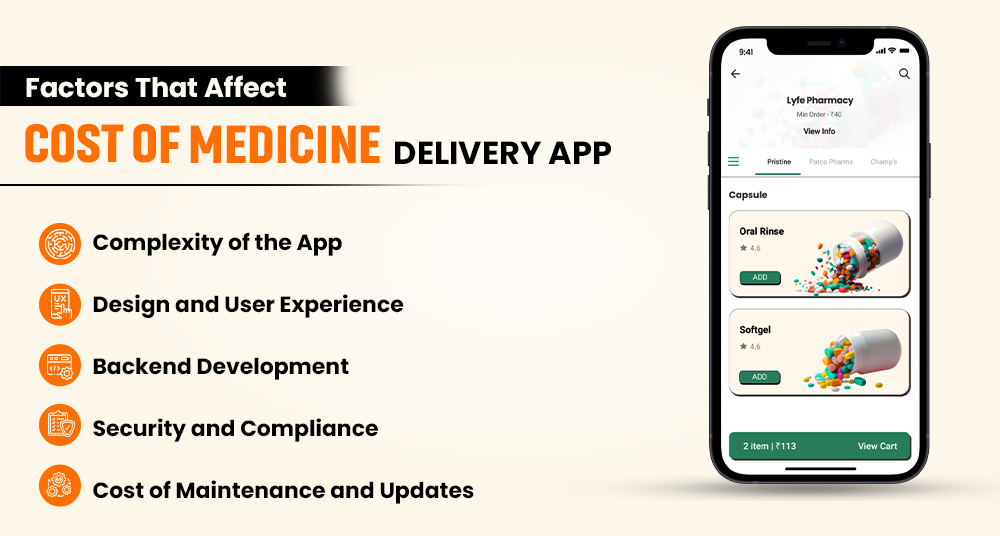
The price of making a drug delivery app depends on many things, such as how complicated the app is, which platform(s) are chosen, where the developers are located, and what features and connections are needed. The main things that affect development costs are broken down below, along with a rough price to give you an idea of what to expect.
Here are certain things that affect the cost of development –
It may be more expensive to make native apps for iOS and Android separately than to use a cross-platform option. However, native apps might work better and make the user experience smoother.
Complexity of the App
The cost is largely determined by the amount and complexity of features. More advanced apps will cost more than simple ones with basic features like registration, searching for medicines, and placing orders. These advanced apps will have AI-based suggestions, robots, and the ability to connect to multiple shops and payment channels.
Design and User Experience
Custom graphics and designs can improve the user experience and raise the cost of development. A good UX/UI design is important for keeping users interested.
Backend Development
The cost will depend on how complicated the server-side code is. This includes managing users, handling orders, keeping track of supplies, and connecting to third-party services.
Security and Compliance
Strong security methods and following healthcare rules (like HIPAA in the US and GDPR in Europe) are necessary, but they can increase the development cost.
Costs of Maintenance and Updates
You should also consider how much your app will cost to maintain, update, and provide customer service. These can be anywhere from 15% to 20% of the annual development cost.
Cost Estimates
The cost of medicine delivery app development with only a few features can be anywhere from $20,000 to $40,000. Some unique features and connections add up to about $40,000 to $80,000 for an app with a modest complexity. It could cost $80,000 to $150,000 or more for a high-end app with AI, chats, complicated interfaces, and unique graphics.
Conclusion
The move toward automation in today’s world greatly affects the creation of medicine delivery apps that meet individuals’ changing needs. Online pharmacies are growing very quickly, which shows that people want more ease in their health care.
This is a great opportunity for traders and people who want to start their businesses. The e-pharmacy market will grow by 12.35% annually from 2023 to 2028.
It’s important to think about different business models, strategy planning, strict security measures, and the use of artificial intelligence as the world of medicine supply continues to change.
Related Guide:
https://blog.synarionit.com/healthcare-app-development-in-2025/




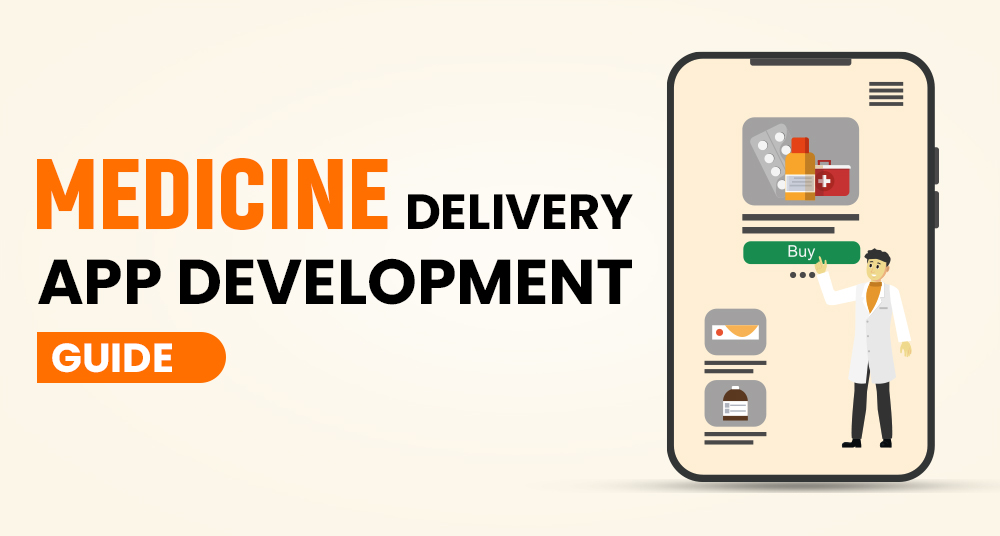
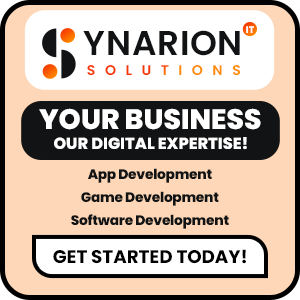
What do you think?
It is nice to know your opinion. Leave a comment.